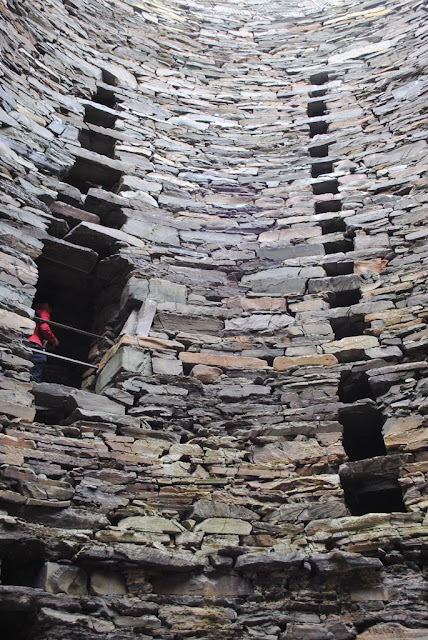Around on the opposite side of the Shetlands we anchored off the incredible Broch of Mousa. A broch is a circular fort from the Iron Age, built entirely of drystone construction. It is thought that they served as a safe retreat when under attack. Most were apparently built during the 1st century AD or BC.
There are thought to be several hundred of them, almost entirely in northern Scotland. Mousa is the most complete of these; most are just a jumble of fallen stones.The drystone construction of these towers, is again amazing. Anyone who has tried to build a drystone wall will understand, but to build one 44 feet high, circular and with hollow walls containing a staircase, seems almost impossible. It certainly would be were it not for the small flat slabs of sandstone on the island. But still, over 40 feet high without any mortar!
The circular shape is amazing inside, with space to sit and a fire ring in the centre. Gaps in the interior walls help reveal the construction and provide light for the stairs as well as galleries with tiny storage chambers.
Yes, it is possible to climb the stairs, built carefully into the hollow walls. To give you an idea of how thick the walls are, the single entranceway passage is 16 feet long!
Of course I had to try climbing the stairs, and came out on top to beautiful views in all directions. You can see the walls, tapered to the top, are still 6 feet thick!
We did get to wander this island for awhile, as only so many people could look inside the broch at one time. There were lots more drystone walls across the landscape.
We watched the Bonxies (or Great Skuas to give them their proper name) soar over the island, seeking their prey. Bonxies, about the size of a large gull, have even been known to attack lambs or Shetland pony foals and have the reputation as a fierce predator.








At last I can comment, I have been reading, but for some crazy reason could not log into my Google account!!! The Scotland series has thrilled me, as my Gran, Grandad and Mum all were born in Scotland, my Gran sailed from Oban to Ireland when she was young, and was a Nanny for a shipping company. Then in 1909 they all sailed to New Zealand. The Broch, what a feat, no fancy tools, and the sheep, hardy souls to exist on some areas that would be cold summer and winter.A friend visited in August many years ago and said for 3 weeks it rained every day. Remembering William,he will always be close in your hearts.
ReplyDeleteThat is impressive construction!
ReplyDeleteWow! Fascinating and very long lived, it seems. Thanks for the great stories!
ReplyDeleteThat is amazing. They were real engineers back then
ReplyDeleteHaving done a bit of work on a dry stone wall many years ago, I can't imagine the time involved -- nor the skill. A neighbor who'd worked on many wall built his last stone wall in his 80s, but continued to cut and split firewood by hand.
ReplyDeleteAs someone who once helped in building a small stone wall as a garden feature - it took ages to complete and fell down within a few months - I can only be amazed at the skills of these early builders. Thanks for showing us such an incredible site.
ReplyDeleteJust amazing! I'm always so impressed with the ingenuity and tenacity of those who lived so long ago.
ReplyDeleteI can’t recall Mousa in the Shetland series, but Fait Isle has made an appearance or two. BTW those structures are pretty awesome.
ReplyDeleteMarvelous! A new term to me too.
ReplyDeleteI'd not heard of a broch before now.
ReplyDeleteLovely post.
All the best Jan